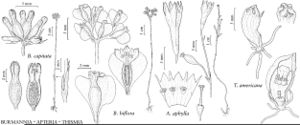Burmanniaceae
Herbs, annual or perennial, mycotrophic and white or purplish, or autotrophic and green. Roots subterranean, mycorrhizal, filiform or stoutly terete. Stems monopodial, unbranched or with few branches, erect, slender; rhizomes present or absent. Leaves present or absent, cauline or basal, alternate, simple, sessile, often scalelike, margins entire; stipules absent. Inflorescences terminal cymes, sometimes appearing racemose or capitate, or flowers solitary; each flower subtended by scalelike floral bract. Flowers: tepals 6, partially or wholly connate, tube persistent or caducous in fruit, limb lobes 3 in 1 whorl or 6 in 2 whorls, greenish, purple, or white, sometimes blue-tinged, often ribbed or winged, throat with or without annulus; stamens 3 or 6, sessile or subsessile; pollen sacs separated on appendaged connective or connective broadened and connate, forming ring proximal to annulus; pistil 1, ovary inferior, 1- or 3-locular; placentation parietal or axile; ovules numerous; style 1, 3-branched apically; stigmas 3. Fruits capsules, ovoid, obconic, or cup-shaped; dehiscence transverse, longitudinal by 3 valves, or irregular. Seeds numerous, minute.
Distribution
Mostly tropical and subtropical, worldwide.
Discussion
Genera ca. 15, species ca. 125 (3 genera, 5 species in the flora).
Although Burmanniaceae have traditionally been placed in the Orchidales, it has been suggested that the family may be more closely related to the Melanthiales (= Liliales in the broad sense, as traditionally circumscribed) (R. M. T. Dahlgren et al. 1985). More recently, molecular and morphological studies by L. R. Caddick et al. (2000, 2000b) support placement of the family in the Dioscoreales.
Burmanniaceae traditionally have been characterized as saprophytic, but the life form is more accurately described as mycotrophic or myco-heterotrophic (J. R. Leake 1994). Even the photosynthetic species have been shown to be endomycorrhizal (P. J. M. Maas et al. 1986b; C. E. Wood Jr. 1983) and have been described as hemisaprophytic. Saprophytism in the Burmanniaceae and other achlorophyllous families has been fully discussed by J. R. Leake (1994).
Selected References
Illustrations
| Family ⠉ | Taxon | Illustrator ⠉ | |
|---|---|---|---|
 | Burmanniaceae Burmanniaceae Burmanniaceae Burmanniaceae | Burmannia capitata Burmannia biflora Apteria aphylla Thismia americana | John Myers John Myers John Myers John Myers |
Key
| 1 | Leaves and stems green; ovary 3-locular; placentation axile. | Burmannia |
| 1 | Leaves and stems white or purplish; ovary 1-locular; placentation parietal. | > 2 |
| 2 | Flowers purplish or white with purplish longitudinal stripes and apices of perianth lobes; inflorescences usually racemose cymes; stem much longer than 1 cm; perianth lobes all erect, not connate at apex. | Apteria |
| 2 | Flowers white with faint blue-green markings on lobes; flowers solitary; stem 1 cm or less; perianth lobes 3 recurved, 3 inflexed and convergent to connate at apex. | Thismia |